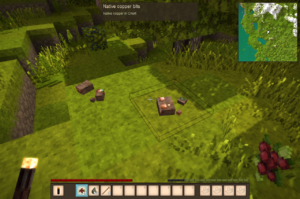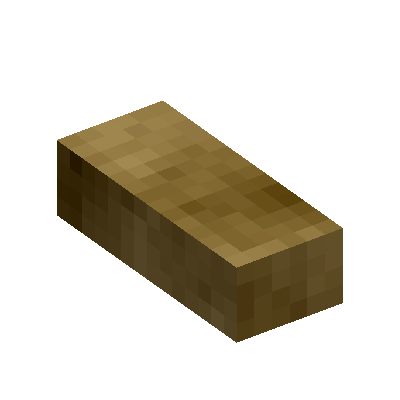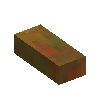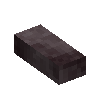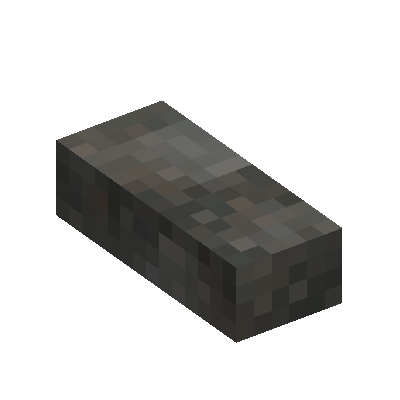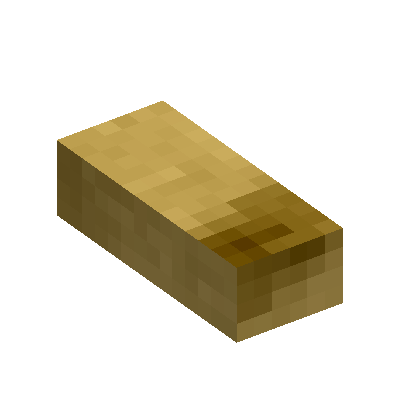Casting/ru: Difference between revisions
Akellagray (talk | contribs) (Created page with "Формы") |
Akellagray (talk | contribs) (Created page with "Литье в основном используется для изготовления металлических инструментов из меди и бронзы, ко...") |
||
| Line 1: | Line 1: | ||
Литье в основном используется для изготовления металлических инструментов из меди и бронзы, которые выплавляются в жидком состоянии и отливаются в формы или заготовки для создания оголовий инструментов. С помощью этого процесса также могут быть превращены в слитки или сплавы руды из основного металла в слитки. | |||
__TOC__ | __TOC__ | ||
== | |||
== Обязательные материалы == | |||
Чтобы отливать металлические предметы, игрокам нужны [[crucible|тигель]], [[firepit|Костёр]], топливо ([[coal|уголь]] или [[charcoal|древесный уголь]]), [[molds| глиняные формы]], созданные [[Clay Forming | формирование глины]] и [[metall| Металлы]] самородки. [[File:Native copper in chert.png|300px|thumbnail|right|Медная руда может быть найдена в небольших залежах камней на поверхности.]] | |||
=== Casting Tool Availability === | === Casting Tool Availability === | ||
Revision as of 03:10, 26 April 2020
Литье в основном используется для изготовления металлических инструментов из меди и бронзы, которые выплавляются в жидком состоянии и отливаются в формы или заготовки для создания оголовий инструментов. С помощью этого процесса также могут быть превращены в слитки или сплавы руды из основного металла в слитки.
Обязательные материалы
Чтобы отливать металлические предметы, игрокам нужны тигель, Костёр, топливо (уголь или древесный уголь), глиняные формы, созданные формирование глины и Металлы самородки.
Casting Tool Availability
- Axe: (Harvesting) Damages Wood, Leaf and plant blocks including trees, logs, planks, fences, gates and wooden building components. Used to create firewood.
- Hammer: (Crafting) Used in smithing, and to crush stones/ores in the crafting grid when no quern is available.
- Hoe: (Crafting) Used in farming to convert soil into farmland.
- Pickaxe: (Harvesting) Damages Rock, Stone and Ceramic blocks; used to harvest rock and ores.
- Propick: (Harvesting) Damages Rock blocks; used to detect the presence of ores when mining.
- Shovel: (Harvesting) Damages Terrain blocks including Soil, Clay, Peat, Sand, and Gravel. Used to harvest terrain blocks or terraform the landscape.
- Sword: (Weapon) Damages Mobs; used as a melee combat weapon
Obtaining Ores
Metal nuggets can be obtained by panning. Small stones containing metal ores also appear on the surface of the world and are a good early game source of metal nuggets. To gather surface deposits, "breaking" the ore containing stones (with an empty hand or any item) to converts the stones into ore nuggets for collection. These surface deposits are an indicator of larger underground ore deposits. Be sure to add a waypoint to mark the location for later mining operations.
Preparing Ores
Nuggets obtained by collecting small stone surface deposits or panning are "ready to use" and do not require additional processing. Ores collected by mining are trapped in the parent stone. Stone and metal ore chunks must be placed in the crafting grid with a hammer to crush the stone and obtain smeltable ore nuggets. Each nugget contains 5 units of base metal.
Smelting Metal
Smelting is performed in a crucible. The crucible will hold four complete stacks of 128 nuggets, but only one material type, base metal or alloy, may be smelted at a time.
Preparing the Crucible
- Place the crucible in the input slot of the firepit to access the crucible GUI.
- Add ore nuggets (5 units each) into the four input slots of the crucible GUI. Ore amounts and types can be chosen based on which metal or alloy is to be created, and how much material is required to fill the selected molds.
- When the correct ingredients for an alloy are added, the GUI displays the amount (metal units) and type of material that will result from the smelting process
- Add fuel, Peat, coal or charcoal and light the firepit. Be sure to select the fuel appropriately, the fuel must raise and maintain the temperature of the metal above the melting point to liquefy the ores within the crucible.
- When the metals are liquefied, the glowing crucible will shift to the firepit output slot.
Adding ores after the process begins resets the temperature.
Casting Metals
Metal ores and alloys with melting points at or below 1300°C can be smelted in a crucible and cast to form metal ingots prior to smithing or tool heads using clay molds. Copper and Bronze Alloys may be cast into tool heads using clay molds.
Tool heads and ingots require 100 metal units (20 ore nuggets) per item
Filling Molds
- Place the ingot or tool head mold to be filled on a solid surface (Sneak + RMB). Tool molds occupy one block, but ingot molds may be placed two to a block.
- Pick up the glowing crucible will appear glowing and will shift to the firepit output slot (GUI: right).
- With the crucible in an active hotbar slot, select the mold with the display crosshairs and use RMB to pour materials into the ingot or tool mold.
- When the mold is filled, no more metal can be added to the mold.
- The metal will cool in the mold, and item temperature can be viewed in the block GUI.
- When the metal is cold, ingots and tool heads can be removed from the molds (RMB).
If a player attempts to pick up a mold before the metal is cool, the liquid material will be lost. A partially filled mold cannot be picked up without losing the material, even after the metal cools.
Alloy Ratios
- Tin bronze, a mixture of copper and tin, has twice the durability of copper.
- Bismuth bronze, a mixture of copper, bismuth, and zinc, has slightly higher durability than tin bronze. In comparison to Tin Bronze, weapons and tools made from bismuth bronze are slightly slower (reduced mining speed) and have reduced attack power (HP).
- Black bronze is a mixture of copper, gold, and silver. It has the highest durability of all bronze alloys.
Tutorial Video: Casting
| {{{title}}} | |
|---|---|
